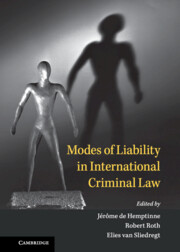Book contents
- Modes of Liability in International Criminal Law
- Modes of Liability in International Criminal Law
- Copyright page
- Contents
- Biographies
- Acknowledgements
- Abbreviations
- 1 Cross-Cutting Issues
- Part I Individual Commission
- Part II Joint Commission
- Part III Participation
- Part IV Participating in Group Activities
- Part V Inchoate and Preparatory Acts
- Part VI Other Forms of Responsibility
- 15 Command Responsibility
- Part VII Concluding Observations
- Index
- References
15 - Command Responsibility
from Part VI - Other Forms of Responsibility
Published online by Cambridge University Press: 01 July 2019
- Modes of Liability in International Criminal Law
- Modes of Liability in International Criminal Law
- Copyright page
- Contents
- Biographies
- Acknowledgements
- Abbreviations
- 1 Cross-Cutting Issues
- Part I Individual Commission
- Part II Joint Commission
- Part III Participation
- Part IV Participating in Group Activities
- Part V Inchoate and Preparatory Acts
- Part VI Other Forms of Responsibility
- 15 Command Responsibility
- Part VII Concluding Observations
- Index
- References
Summary
Command responsibility, as a modern doctrine of criminal law, originates in the atrocities committed by members of the Imperial Japanese Army in the Philippines between 9 October 1944 and 2 September 1945. That the atrocities – starvation, execution, rape and burning of homes – violated the laws of war is uncontroversial. More controversial, and of enduring doctrinal interest, was the potential individual responsibility of General Yamashita, Commanding General of the Imperial Army’s Fourteenth Group prior to his surrender to US forces.
- Type
- Chapter
- Information
- Modes of Liability in International Criminal Law , pp. 409 - 432Publisher: Cambridge University PressPrint publication year: 2019
References
Select Bibliography
- 3
- Cited by

